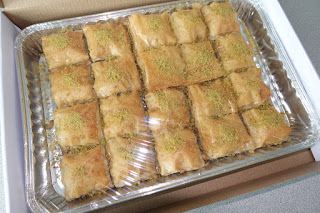The situation in Syria has been pretty awful over the last several years due to the ongoing civil war that started with the Arab Spring. Very many have lost their lives and very many have been displaced and are refugees. One of them, a former cafe owner/baker from Aleppo, Syria made his way to Providence and with his own investment and help from other organizations opened up a cafe named after the city he left - Aleppo Sweets!
 |
| Aleppo after the civil war! |
 |
| It lives on in Aleppo Sweets! |
It is on the east side of Providence, by Brown University, and has been described by our colleague who visited as very cute, and very authentic. Her husband is Arabic so we take her word for it. Today she introduced us to one of their products - a classic baklava!
 |
| Baklava or latter day placenta! |
Baklava is served all over the Mediterranean regions from Greece over to the countries in Northern Africa. Although it is mainly associated with these regions it may have had a Roman origin that at the time was called placenta. According to Wikipedia:
The oldest (2nd century BCE) recipe that resembles a similar dessert is the honey covered baked layered-dough dessert
placenta
of Roman times, which Patrick Faas identifies as the origin of baklava:
"The Greeks and the Turks still argue over which dishes were originally
Greek and which Turkish. Baklava, for example, is claimed by both
countries. Greek and Turkish cuisine both built upon the cookery of the
Byzantine Empire, which was a continuation of the cooking of the Roman
Empire. Roman cuisine had borrowed a great deal from the ancient Greeks,
but
placenta (and hence baklava) had a Latin, not a Greek, origin—please note that the conservative, anti-Greek Cato left us this recipe."
Shape the placenta as follows: place a single row of tracta along the whole length of the base dough. This is then covered with the
mixture [cheese and honey] from the mortar. Place another row of tracta on top and go on doing so until all the cheese and honey have been used up. Finish with a layer of tracta. ... place the placenta in the oven and put a preheated lid on top of it ... When ready, honey is poured over the placenta.
Isn't that interesting!! Of course placenta is something totally different today. Anyway, what we ahd is supposed to be Syrian style. So it was made or cut into little square/dianond shapes. You have the filo dough on the bottom and then a layer of crushed walnuts, then more filo on the top. It is finally held together with sugar syrup or honey and in this case there was pistachio nut dust on the top for appearance and taste.
 |
| The top with the pistachio dusting! |
 |
| Flakey filo pastry and the crushed walnut layer! |
 |
| It was hard to eat just one! |
This was very, very good! Despite the sugar or honey it was not crazily sweet, was very soft to eat though the filo was still flakey, and the taste of the nuts was subtle and not overpowering. It was so tasty that several of our reticent consumers indulged themselves in more than one piece. Needless to say it was a nice introduction to what Aleppo Sweets has to offer and we look forward to more.






No comments:
Post a Comment